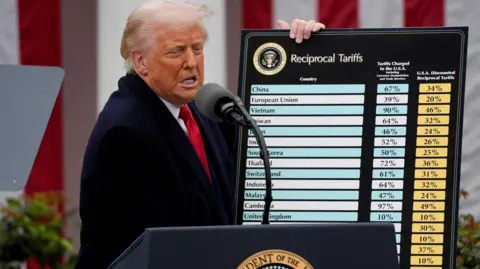In recent months, the conversation around trade tariffs has intensified, becoming a focal point in global economic strategy, diplomatic relations, and market stability Tariff News. This article explores the latest developments, the driving forces behind them, and how countries — including Pakistan — are being affected.
What’s happening?
-
The Donald Trump administration in the United States announced sweeping new tariff measures, including a universal baseline tariff of 10% on all imports and reciprocal tariffs that vary depending on how countries treat U.S. exports. The Friday Times+3The Express Tribune+3Profit by Pakistan Today+3
-
For example, the U.S. slapped a 29% tariff on Pakistani exports, citing trade imbalance and what was deemed unfair treatment of American goods. The Express Tribune+2Profit by Pakistan Today+2
-
In the meantime, the International Monetary Fund (IMF) has warned that these tariffs are dragging on global economic growth. The Washington Post+1
-
And the Organisation for Economic Co‑operation and Development (OECD) projects that tariffs will increasingly hurt the U.S. and global economies in the medium term. The Wall Street Journal
Why now? — The motivations & context
Several factors are driving the resurgence of tariffs as a policy tool:
-
Trade imbalances: The U.S. has long pointed to large trade deficits with various nations, arguing that some countries benefit unfairly from export‑led growth, subsidized industries or steep tariffs on U.S. goods. The new U.S. tariff policy explicitly links the rate to reciprocal tariffs: countries that impose higher tariffs on U.S. goods face higher U.S. tariffs in return. Reddit+1
-
Manufacturing resurgence & protectionism: Some U.S. policy makers believe raising import tariffs will protect domestic manufacturing, create jobs, and re‑balance supply chains.
-
Geopolitical strategy: Tariffs are being used not only for economic ends, but as a diplomatic instrument. For example, some countries face steeper tariffs because of geopolitical alignments or trade practices. Dawn+1
-
Changing global trade architecture: Institutions such as the World Trade Organization (WTO) have been under pressure to modernize, but some governments are reverting to unilateral tariffs rather than multilateral negotiation. ICC – Näringslivets världsorganisation
Impacts on Pakistan & beyond
Pakistan’s situation
Pakistan is a clear case study of how these changes play out for emerging exporting nations:
-
Pakistan’s exports to the U.S. are substantial — over US $5 billion annually, with textiles forming around 80% of the value. The Friday Times+2The Indian Express+2
-
The imposition of a 29% tariff by the U.S. could reduce Pakistan’s exports to the U.S. by 20–25%, equating to losses of US $1.1–1.4 billion. The Nation+1
-
The government has established a high‑level steering committee and technical working group to assess and respond to the tariffs. Arab News PK+1
-
While the government says it won’t retaliate, the export sector is alarmed about competitiveness, margins, and jobs. Business Recorder+1
Global ripple effects
-
Global growth forecasts have been revised downward because of elevated tariffs and trade uncertainty. The IMF projected global growth at just 2.8% for 2025. The Washington Post+1
-
The U.S. average duty rate has surged (reported around 20.1% in 2025) — the highest since the 1910s — which raises concerns about inflation, supply‑chain disruption and trade retaliation. The Times of India
-
Some sectors are more vulnerable: textiles, apparel, manufacturing of processed goods, supply chains dependent on imports of intermediate goods. As goods become costlier, downstream effects increase.
-
Markets & business‑confidence are impacted: Firms facing higher tariffs may delay investment, adjust sourcing, shift production, or relocate altogether.
What are the risks & opportunities?
Risks
-
For exporters in Pakistan and other developing countries: Loss of competitiveness if tariffs make their products more expensive relative to competitors.
-
For domestic consumers in importing countries: Tariffs often lead to higher prices, lower variety, delayed product innovation or higher costs of production (which may be passed on).
-
For global trade & growth: Prolonged or escalating trade barriers may reduce trade volumes, slow investment, fragment supply chains and dampen growth.
-
Retaliation / trade war risk: If trading partners respond with their own tariffs, the dynamics can escalate quickly. For instance, the EU and China have already expressed strong opposition to U.S. reciprocal tariffs. New York Post
Opportunities
-
Export‑diversification: Countries like Pakistan are being forced to rethink their dependence on a few sectors (e.g., textiles) and explore higher value ‑added exports, new markets, and upgraded production.
-
Supply‑chain shifts: Some firms may relocate sourcing or production to countries with more favourable tariff regimes — presenting opportunities for those agile enough.
-
Negotiation leverage: Tariff announcements sometimes accompany negotiation windows; countries can engage with the imposing nation to secure exemptions, phased reductions or special terms. For example, Pakistan is undertaking dialogues with the U.S. to address its tariffs. Business Recorder+1
What to watch going forward
-
Negotiations & trade deals: Will new arrangements emerge that mitigate tariffs, or will such measures become the norm of global trade?
-
How other countries respond: Will major trade partners retaliate, or seek exemptions? Will multilateral institutions enforce dispute‑resolution?
-
Sectoral impacts: Which industries will shift production? How will exporters adjust? How quickly will businesses reorganize supply chains?
-
Domestic policy responses: How will countries like Pakistan react — through subsidies, export incentives, trade diversification, or bilateral/ multilateral agreements?
-
Consumer price & inflation effects: As tariffs increase costs of imported inputs, will inflation accelerate in importing economies? How will central banks respond?
-
Structural change: Will we see longer‑term shifts in global trade architecture: less off‑shoring, more regionalisation, more high‐value manufacturing in developing countries, or fragmentation of global value chains?
Conclusion
Tariff policy — once considered a relic of early‑20th‑century trade wars — is very much back in the spotlight. The U.S.’s recent moves mark a bold pivot in trade strategy: referencing not just tariff levels but trade balances and reciprocity, and applying steep rates in many cases. The ripple effect is global: exporters like Pakistan face real risks, global growth projections are being revised downward, and the architecture of trade is under stress.
